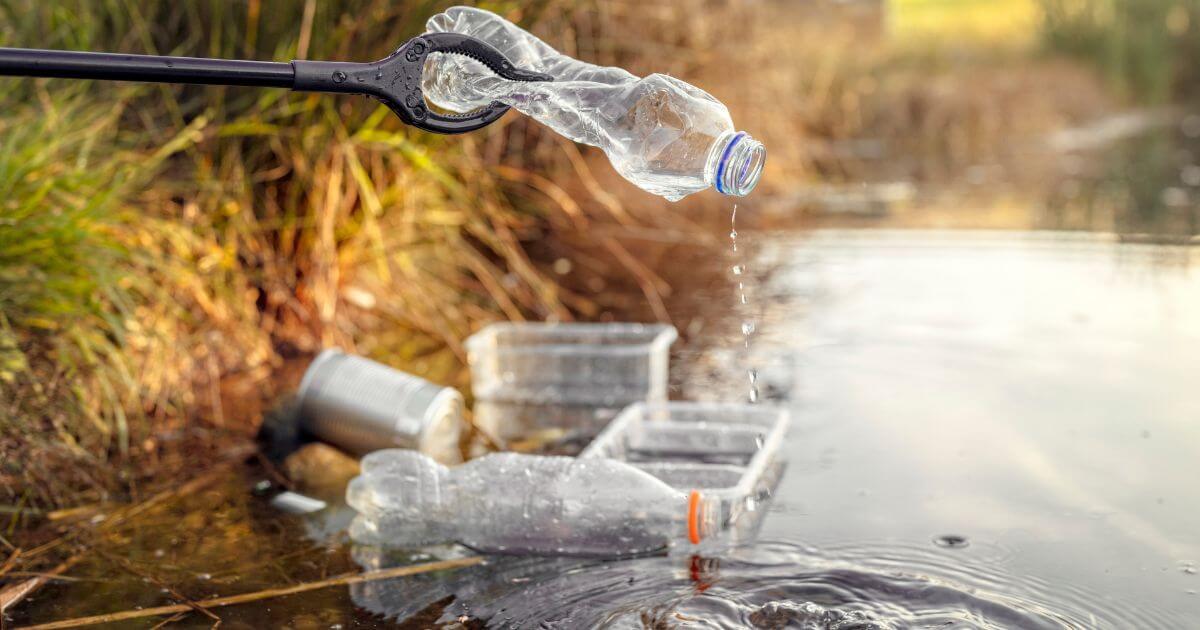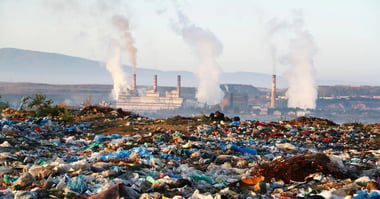
Tamara Davison
Tamara Davison is a journalist who specializes in sustainability and the environment. Reporting from around the world, she's seen firsthand the direct impact waste is having on coastal communities and our oceans. As a diver trained in ecological monitoring, the changes Tamara has seen in marine habitats inspired her to action. She's previously written for The Guardian, The Independent and the Evening Standard. She's also produced environmental documentaries for EuroNews.
The amount of plastic waste generated worldwide is expected to triple by 2060 (OECD, 2022). According to the United Nations (UN), single-use plastic packaging used for products makes up a third of all plastic created, meaning many brands contribute to our world’s plastic problem.
Plastic neutrality is a term that we’re hearing a lot more in business settings in response to this. Unlike carbon neutrality, plastic neutrality centers on removing plastic waste from the environment, and it’s one of several initiatives businesses use to counter plastic output.
‘Neutrality’ through the sustainability lens has also received a lot of negative press recently, but we’re here to tell you how it can be used as a tool for businesses to work towards sustainability.
Want to reduce your business’s plastic footprint? We can help. All you have to do is get in touch with our in-house team. Once we’ve received your details, we can arrange a call to discuss which plastic recovery plan will suit your business needs best.
What’s on this page?
01 | What is plastic neutrality?02 | The importance of businesses reducing their plastic footprints
03 | How can businesses go plastic neutral?
04 | Is plastic neutrality greenwashing?
05 | Summary
06 | FAQs
What is plastic neutrality?
Plastic neutrality is when businesses recover as much plastic waste from the environment as they produce. It’s essentially an offsetting strategy that enables companies to take ownership of their plastic waste footprint and help the environment.
This means businesses still produce plastic but are doing something about the resulting waste.
The first step to becoming plastic neutral requires businesses to measure the amount of plastic they produce. They then purchase plastic credits that help fund plastic recovery projects that remove the same amount of plastic waste from the environment. The collected waste is then recycled or disposed of more sustainably, such as through co-processing.
Other steps can help achieve plastic neutrality. For instance, brands can also prevent plastic from entering our environment by adopting in-house recycling and reuse schemes that similarly reduce output alongside plastic waste collections.
Plastic neutrality is not a silver bullet, but it encourages businesses to think long-term about their products' impacts.
It also helps businesses align with extended producer responsibility (EPR) policies, a type of environmental initiative gathering traction in various countries. EPR dictates that businesses are responsible for the end-of-life waste their products produce, even if they pass it on to consumers first. So, plastic neutrality demonstrates brands are taking that into account.
The importance of businesses reducing their plastic footprints
We know plastic waste has adverse effects, but reducing plastic isn’t easy for a lot of brands. Although 75% of companies committed to sustainable packaging alternatives in 2022, McKinsey found that just 30% of those surveyed were prepared to meet government requirements or fully implement these commitments.
Plastic neutrality helps businesses achieve sustainability goals through an alternative route and has several benefits.
Environmental benefits
Up to 10 million tons of plastic waste enter our oceans each year, slowly breaking into microplastics that negatively impact our environment. Studies have suggested that plastic in our seas may affect our ocean’s ability to absorb carbon dioxide, speeding up our climate crisis due to emissions — this is known as a negative feedback loop.
The production of plastic has also been linked to climate change. Not only are plastics made from fossil fuels, but they also release methane and ethylene as they break down, according to a Hawaii University study – and methane is at least 84 times worse for the climate than CO2 over a 20-year period.
You can learn more about this on our page How Does Plastic Affect Climate Change?
Funding plastic collections as part of a plastic neutrality initiative gives brands an active role in reducing waste floating in our oceans. Every piece removed and recycled can help relieve pressure on our struggling ocean ecosystems.
Health benefits
A 2022 study found 75% of fish in New Zealand contained microplastics. In some cases, microplastics are so tiny that they’re easily ingested by marine life — before entering the human food chain. We’re only just discovering the impact of plastics on human health, but alarming studies have already found these particles in many parts of the human body.
Purchasing plastic credits can help brands be a solution to this problem, as it slows the volume of waste entering the environment, facilitating a circular economy model in which plastics don’t get the chance to enter our food systems.
Supports wildlife
Scientists have estimated that around 100,000 marine animals and 1 million seabirds die each year from getting entangled or ingesting plastic. Plastic waste has an immense impact on the natural world, from suffocating coral reefs to impacting food chains.
Businesses committed to plastic neutrality help fund the removal of large pieces of plastic that many sea creatures may have otherwise ingested.
Financial incentives
Governments and authorities worldwide are starting to implement increasing regulatory pressure on businesses regarding sustainability initiatives. More and more companies are being fined for greenwashing, and this will increase in the future as more legislation comes into place.
In addition, at least 91% of consumers are now concerned about plastic waste, and these shoppers want to support brands that share their values.
Businesses that adopt environmental, social, and governance (ESG) policies, and invest in plastic neutrality within those policies, build resilience in their operations while attracting the right customers.
This can help a brand better position itself in preparation for further regulation and waste management expectations in the future.

How can businesses go plastic neutral?
Deciding to become plastic neutral is a big step; luckily, plenty of organizations can help you do it right. Working with a reputable third party means you can focus on your brand’s vision while plastic experts (like CleanHub) help you quickly and effectively achieve plastic neutrality.
Here are some of our tips:
- Partner with an organization that can help you audit your existing plastic waste output, as this will help you make well-informed decisions about reducing waste and show your commitment to the environment.
- Implement technology to help you better monitor and incentivize your supply chain, to maintain sustainable practices and avoid unnecessary plastic waste.
- Get involved with a plastic credits initiative that allows you to fund the removal of plastic waste from the environment based on the amount of waste your company produces. Look out for companies that have sustainable accreditation and that are transparent about their operations. At CleanHub, we prioritize this through advanced track-and-trace technology, meaning our partners can hold us accountable and see proof of waste being collected piece by piece.
- Switch to a closed-loop waste model that encourages customers to return their plastic waste to your organization. Many beauty brands now offer refillable products, for example, to reduce waste.
The difference between ‘plastic neutral’ and ‘plastic free’
The terms plastic neutral and plastic free have arisen in response to growing waste; they may sound similar but have different meanings.
Businesses often use the term ‘plastic free’ to focus on products that aren’t made with plastic materials. These products are often packaged in biodegradable materials or sustainable alternatives — for example, plastic-free solid beauty products made from organic ingredients that don’t require plastic packaging.
You don’t get many companies identifying as plastic-free themselves, as it would suggest all of their operations are free of plastic, which is challenging to implement and track.
‘Plastic neutral’ means businesses still use plastic, but the company is taking action to stop plastic from polluting the environment — helping to support a circular economy. Their output and collections of plastic are equal, meaning they can reduce their impact on the planet by lowering their plastic waste levels.
Making plastic neutrality part of a wider plan
We’ve said it before, and we’ll say it again: plastic neutrality shouldn’t be your only focus.
When done right, it should form part of a broader initiative that approaches sustainability from various angles.
Develop an ESG strategy with plastic neutrality as one of several targets to help you become a better brand.
This involves championing a circular economy model where you not only support the recovery of materials but also encourage customers to get involved with recycling and reuse.
Is plastic neutrality greenwashing?
‘Neutrality’ has received a lot of stick recently because some companies use terms like carbon neutral and plastic neutral to mislead customers about their practices. Carbon emissions, in particular, have faced a lot of criticism because it’s difficult to measure them and hold brands accountable for their impact.
The WWF claims plastic credits “could encourage business-as-usual practices” without businesses actually implementing plastic neutrality across all their operations. Indeed, if a company's only focus is plastic neutrality, it can be linked to greenwashing.
Despite concerns, many leading organizations recognize the importance of having plastic neutrality initiatives in place. The UN Environment Programme, for example, said plastic credit mechanisms “play a significant role within sustainable waste management systems,” adding that when implemented properly, they are a “short-term remedy while we move to better waste and resource management systems.”
Plastic credits are also different from carbon credits as they’re tangible. You can see the results of plastic credit initiatives in the coastal communities it helps and the mountains of waste that get recycled.
Adopting a more robust sustainability strategy and partnering with a reputable plastic credit provider can help you reduce the risk of greenwashing. We also believe regulation is critical to the future of the plastic neutrality market, and government agencies' backing will help validate the positive impacts of plastic neutrality initiatives.
Want to learn more? Check out our comprehensive guide: Is Plastic Neutrality Greenwashing?
Summary
Plastic neutrality alone will not solve the growing plastic crisis but is part of a greener business future. For many, plastic neutrality can help inspire their team, raise consumer awareness, and spur further action among shareholders — not to mention it allows brands to take immediate and effective action on their plastic footprint.
Of course, some existing plastic neutrality initiatives can present some challenges, which mostly come down to a lack of clarity when it comes to recovery efforts. That’s why partnering with the right plastic credit provider can make all the difference.
At CleanHub, we’ve helped hundreds of brands develop plastic waste strategies that make a difference while contributing to a circular economy future. Plus, our track-and-trace system brings a new level of transparency to plastic recovery.
With us, plastic neutrality isn’t just an investment in waste recovery — it’s an investment for a healthier planet and cleaner oceans for decades to come.
Want to join hundreds of brands reducing their plastic footprint? Get in touch with our in-house team who can arrange a call to discuss which plastic recovery plan will suit your business needs best.
FAQs
What is a plastic-waste-neutral company?
A company that identifies as plastic neutral removes as much plastic waste from the environment as the plastic it produces. Hence, its plastic footprint is ‘neutral.’ Brands should partner with accredited plastic credit providers that help them with plastic audits and waste management strategies.
Why is plastic neutrality important?
Plastic neutrality is one of many strategies that can help brands support a circular economy. It can help limit plastic waste entering our environment while supporting coastal communities on the front line of the climate crisis.
What is carbon neutral plastic?
Being carbon neutral is different from being plastic neutral. Carbon neutral is a term businesses use when they try to offset the amount of carbon emissions they create.
Brands that make carbon-neutral plastic bottles claim to have offset the emissions it took to manufacture the bottle. However, this is also an ambiguous claim that’s hard to monitor — we recommend companies strive for more reputable initiatives, such as plastic neutrality.













